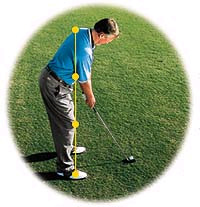教你练:正确打高尔夫 Play Golf
分类: 体育英语
 To maintain this one o’clock posture through to the end, it helps to picture your head resting on a pillow at the finish.
To maintain this one o’clock posture through to the end, it helps to picture your head resting on a pillow at the finish. Since the lie angle (the angle from the ground to the shaft when the club is soled) of most clubs is built around 60 degrees -- about 65 degrees for the shortest clubs and 55 degrees for the longest -- you must bend forward about 30 degrees, or to one o’clock, to reach this optimum 90-degree angle.
When your address is too erect (12 o’clock posture) or bent over (two o’clock posture), it’s almost impossible to swing the club on this path. When vertical, the tendency is to roll the arms early during the takeaway, promoting a very round swing path. The likely result is a pull and maybe even a topped shot. When hunched over, the tendency is to swing the club too much from the inside. This makes it difficult to clear the left side of the body out of the way during the downswing, leading to an open clubface, and, in most cases, a shot pushed to the right.
ESTABLISHING THE correct forward tilt at address is only one element of good posture. The other is making sure all your weight-bearing joints are lined up at address. The top of your spine, insides of your elbows, fronts of your knee caps, and balls of your feet should be aligned vertically. This promotes good balance and posture during the swing.
At address, picture yourself standing on a balance beam. To prevent yourself from falling off, you have to balance out these joints. Leaning too far back (on your heels) or too far forward (on your toes) will tip you off the beam.